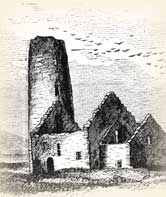
In 1862, when Lars Skrefsrud asked the Norwegian Missionary Society to send him out as a missionary, the mission leaders in Stavanger, Norway turned him down. They didn't want an ex-con representing them on the foreign field. Lars had just spent four years in prison for theft. But he persevered and became Norway's best-known missionary.
Lars would not give up because Christ had transformed his life. A Norwegian named Hans Hauge had recently led Scandinavia in revival. The influence of Hauge's movement reached Lars even in prison. He read religious books and repented of the alcoholism and wild living that had put him behind bars. He was encouraged by his friend Anna Olsum, who never stopped believing in him. Gifted with the ability to master languages, he learned English and German while in prison.
His knowledge of German came in handy. When the Norwegian Missionary Society rejected him, he turned to the Gossner Mission Society in Germany. This Baptist mission gave Lars the training he needed. From 1861 when he left prison until he left for India in 1863, Lars fasted almost constantly, eating only bread, cheese and water. He was determined to bring his body into submission. During those two years, he attended church services daily.
The Gossner Mission allowed Lars to go to India; he worked his way there at his own expense. There he worked among the Santal people who lived north of Calcutta. Anna joined him on the mission field and they married.
A war between Denmark and Germany left bad feelings. When the Gossner leaders refused to allow Lars to work with his friend Hans Peter Boerreson, a Dane, Lars withdrew from the mission.
Lars and Hans joined another Baptist Mission Society. Soon they left it, too, and formed the Santal Mission. To get the funding they needed from Norway, they had to return to their Lutheran roots. They had abandoned infant baptism but now went back to the practice. The one blot on their record was the misleading information they issued to friends back home on this subject, trying to make it appear they had not really adopted Baptist practice earlier.
In spite of this episode, their work prospered. By 1890, Santal mission had 6,000 baptized church members. The Santal tribe suffered from oppression by their Hindu neighbors. Lars not only labored to obtain British protection for them, but preserved their language by reducing it to written form.
He translated the Bible into the Santal tongue and produced a hymnal using native tunes. He wrote textbooks and even collected traditional Santal myths into a book. The schools that he founded taught farming, animal care, carpentry and other useful skills. Determined to make the Santalese self-sufficient in agriculture, he also wanted to give them a church they could run themselves. "It is the heathenism we want to get rid of, not the national character." He made as few changes in Santal culture as he could consistent with Christianity. When Lars died on this day, December 11, 1910, there were between 15,000 and 20,000 Santal Christians.
Bibliography:
- Bloch-Hoell, Nils E. "Lars O(lsen) Skrefsrud." Biographical Dictionary of Christian Missions, edited by Gerald H. Anderson. Macmillan, 1998.
- "From Hans Nielsen Hauge and Lars Olsen Skrefsrud to Normisjon." Normisjon. http://www.normisjon.no/index.cgi?
section=omnormisjon&page=english - Gordon, Ernest. A Book of Protestant Saints. Chicago: Moody, 1946.
- "Lars Olsen Skrefsrud, Missionary to India 11 December 1910." Lutheran Calendar. http://elvis.rowan.edu/~kilroy/JEK/12/ 11.html
- Neill, Stephen. A History of Christian Missions. Pelican, 1964.
- "Northern Evangelical Lutheran Church (India)." http://www.elca.org/dgm/country_packet/packets/ asia-oceania/india/nelc.html
- "Norwegian Santal Mission." http://www.nla.no/ew/norskmisjon.htm